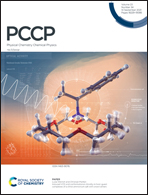Propensity, free energy contributions and conformation of primary n-alcohols at a water surface†
Abstract
Atmospheric aerosols contain organic molecules that serve as cloud condensation nucleation sites and affect the climate. Several experimental and simulation studies have been dedicated to investigate their surface propensity, but the mechanisms that drive them to the water surface are still not fully understood. In this molecular dynamics (MD) simulation study, primary alcohols are considered as a model system representing polar organic molecules. We find that the surface affinity of n-alcohols increases linearly with the length of the hydrophobic tail. By decomposing the adsorption free energy into enthalpy and entropy contributions, we find that the transition from bulk to surface is entropically driven, compatible with the fact that the hydrophobic effect of small solutes is of entropic origin. The enthalpy of surface adsorption is nearly invariant among different n-alcohols because the loss of solvent–alcohol interactions is balanced by a gain in solvent–solvent interactions. Structural analysis shows that, at the surface, the linear alcohols prefer an orientation with the hydrophobic tail pointing out from the surface, whereas the hydroxyl group remains buried in the water. This general behaviour is likely transferable to other small molecules with similar structures but other functional groups that are present in the atmosphere. Therefore, the present study is a step forward toward a general description of organic molecules in aerosols.



 Please wait while we load your content...
Please wait while we load your content...